Top 12 Redpanda Alternative Solutions for 2025

Discover the best Redpanda alternative for your data streaming needs. Compare 12 top solutions for performance, cost, and operational overhead.
Redpanda entered the streaming data landscape with a compelling promise: a Kafka-compatible, high-performance engine designed for simplicity and speed. Its C++ architecture and thread-per-core model offered a fresh take on real-time data processing, attracting developers tired of JVM tuning and Zookeeper dependencies. For many, it delivered on that promise, simplifying deployments and boosting throughput.
However, the ideal streaming platform is not a one-size-fits-all solution. As data ecosystems mature and business requirements shift, teams often re-evaluate their tools. You might be looking for a Redpanda alternative to reduce operational overhead even further with a truly serverless model, lower your total cost of ownership (TCO) at scale, or integrate seamlessly with specific cloud data warehouses like Snowflake or BigQuery. Other common drivers include seeking a fully managed service with a stronger enterprise support system or needing a platform optimized specifically for zero-ops Change Data Capture (CDC) pipelines.
This comprehensive guide is built to help you navigate these choices. We will dive deep into 12 leading Redpanda alternatives, from managed Kafka providers like Confluent Cloud and Amazon MSK to cloud-native solutions like Google Pub/Sub and innovative newcomers like WarpStream. For each platform, we provide a detailed, side-by-side analysis covering:
- Core Features and Architecture: What makes it unique?
- Performance Benchmarks: How does it stack up in real-world scenarios?
- Operational Model & Cost: What are the true operational burdens and pricing structures?
- Ideal Use Cases: Where does this platform truly excel?
- Practical Limitations: An honest look at the potential drawbacks.
Our goal is to equip you with the insights needed to select the right streaming platform for your specific technical and business goals, ensuring your real-time data strategy is built on the best possible foundation.
1. Streamkap
Streamkap presents a compelling and modern Redpanda alternative for organizations that prioritize real-time data movement and processing without the operational burden of managing complex streaming infrastructure. It fundamentally shifts the focus from managing a message broker to delivering end-to-end, low-latency data pipelines. Instead of self-hosting a Kafka-compatible system, Streamkap provides a fully managed, serverless platform built on Kafka and Flink, abstracting away the underlying complexity.

This approach is ideal for data teams who need to stream data changes from operational databases like PostgreSQL, MySQL, or MongoDB into cloud data warehouses and lakehouses such as Snowflake, Databricks, and BigQuery. The platform’s core strength lies in its zero-ops model combined with powerful, integrated capabilities.
Key Features & Use Cases
Streamkap excels where operational efficiency and speed-to-delivery are critical. Its integrated feature set is designed to solve common data engineering challenges out of the box.
- Real-Time CDC & Stream Processing: At its heart, Streamkap offers sub-second Change Data Capture (CDC) with minimal impact on source databases. This enables use cases like real-time analytics, data replication for high availability, and feeding live data into machine learning models.
- Managed Kafka + Flink: Users get the raw power of Kafka's event streaming and Flink's stateful stream processing without ever needing to provision, scale, or patch servers. The platform handles partitioning, scaling, and fault tolerance automatically.
- Automated Pipeline Development: Streamkap significantly accelerates development with dozens of pre-built, no-code connectors. It also provides automated schema drift handling, which prevents pipelines from breaking when source data structures change.
- In-Flight Transformations: Data can be transformed mid-stream using simple SQL or Python, allowing for real-time data cleansing, enrichment, or filtering before it lands in the destination.
Real-World Impact: Customer case studies consistently highlight significant gains. Reports cite outcomes like a 3x lower total cost of ownership, up to 66% cost savings when migrating from other solutions, and a 54% reduction in overall data-related costs, demonstrating a clear ROI.
Pros and Cons
Getting Started
Streamkap offers a free trial, allowing teams to connect sources and destinations to evaluate its performance and usability firsthand. While detailed pricing isn't public, plans are described as flexible and predictable, scaling with usage. The platform is an excellent choice for any organization looking for a powerful Redpanda alternative that favors managed simplicity and high-performance data integration.
Website: https://streamkap.com
2. Confluent Cloud (Managed Apache Kafka)
Confluent Cloud offers a fully managed, enterprise-grade Apache Kafka service, making it a powerful Redpanda alternative for organizations committed to the Kafka ecosystem but seeking to offload operational burdens. It provides turnkey Kafka clusters on major cloud providers (AWS, GCP, Azure) with automated scaling, multi-zone replication for high availability, and a suite of powerful, integrated tools. Its primary appeal lies in its rich ecosystem, which extends far beyond core Kafka.
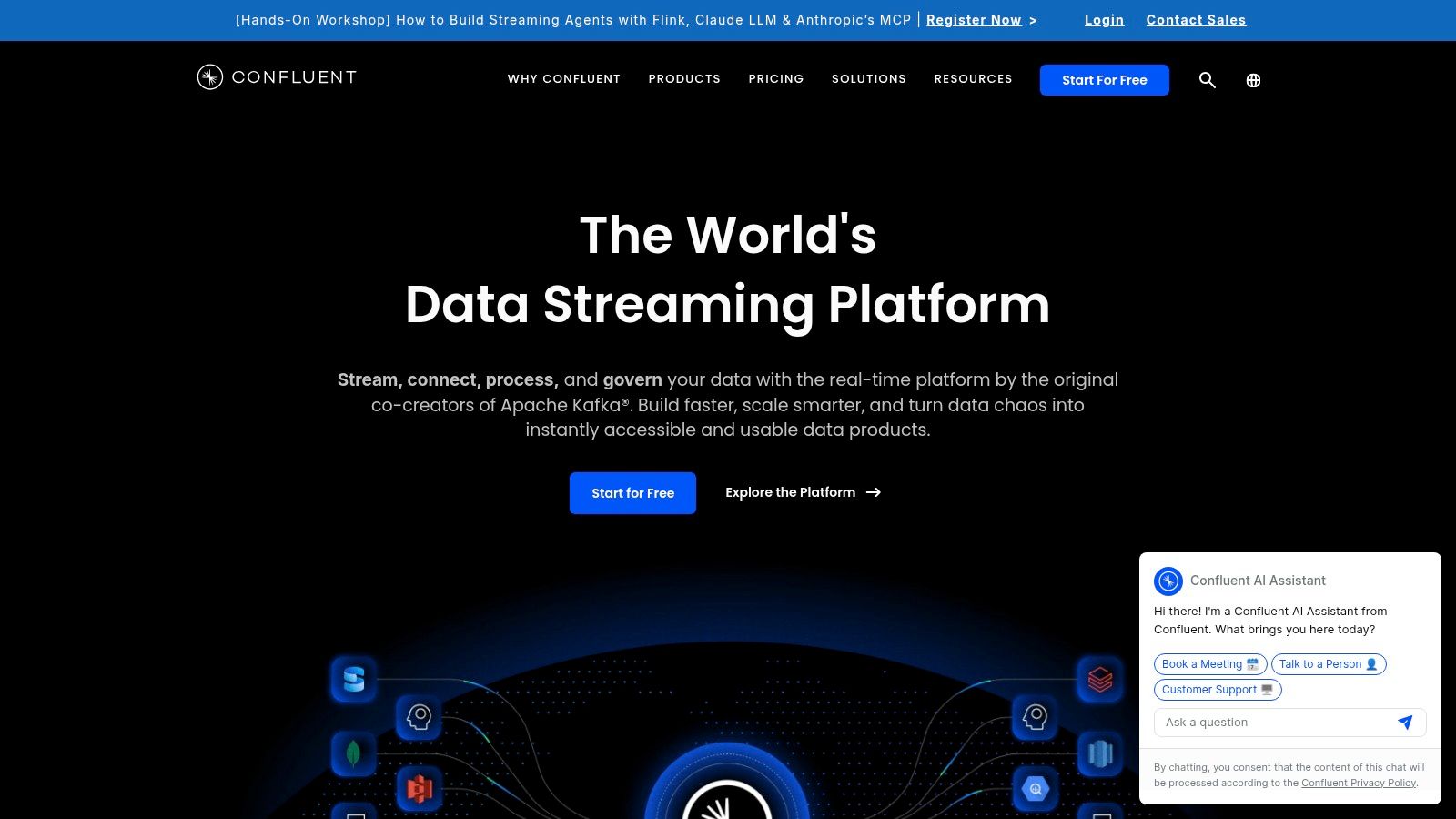
This platform excels in providing a comprehensive, end-to-end data streaming solution. Users gain access to hundreds of pre-built, fully managed connectors for popular sources and sinks, a stream governance suite for data quality and schema management, and the serverless ksqlDB for building real-time data processing applications with SQL syntax. Its Tableflow feature, which materializes Kafka topics into open table formats like Apache Iceberg and Delta Lake, simplifies the integration between streaming data and data lake analytics.
Key Considerations & Use Cases
- Best For: Enterprises needing a mature, battle-tested managed Kafka with extensive governance, security, and a vast connector library out of the box.
- Pricing Model: Confluent Cloud operates on a consumption-based model. Costs are determined by throughput, storage, cluster type, and usage of add-on features like connectors and ksqlDB. This flexibility can lead to cost-effectiveness for small workloads but requires careful monitoring to prevent unexpected expenses at scale.
- Deep, mature ecosystem with widespread enterprise adoption and support.
- Reduces operational overhead significantly compared to self-hosting Kafka.
- The complex, consumption-based pricing can be difficult to predict.
- Costs for connectors, data movement, and advanced features can accumulate quickly.
For teams evaluating its fit, exploring its pricing nuances is crucial. You can learn more about how Confluent Cloud compares to other streaming solutions.
Website: https://www.confluent.io
3. Amazon MSK (Managed Streaming for Apache Kafka)
Amazon MSK offers a native AWS-managed Apache Kafka service, making it a strong Redpanda alternative for teams deeply embedded in the AWS ecosystem. It provides managed brokers, storage, and patching, allowing users to choose between a provisioned model for predictable workloads or a serverless option for variable traffic. Its core advantage is the seamless, native integration with AWS security, networking, and monitoring services like IAM, VPC, and CloudWatch.
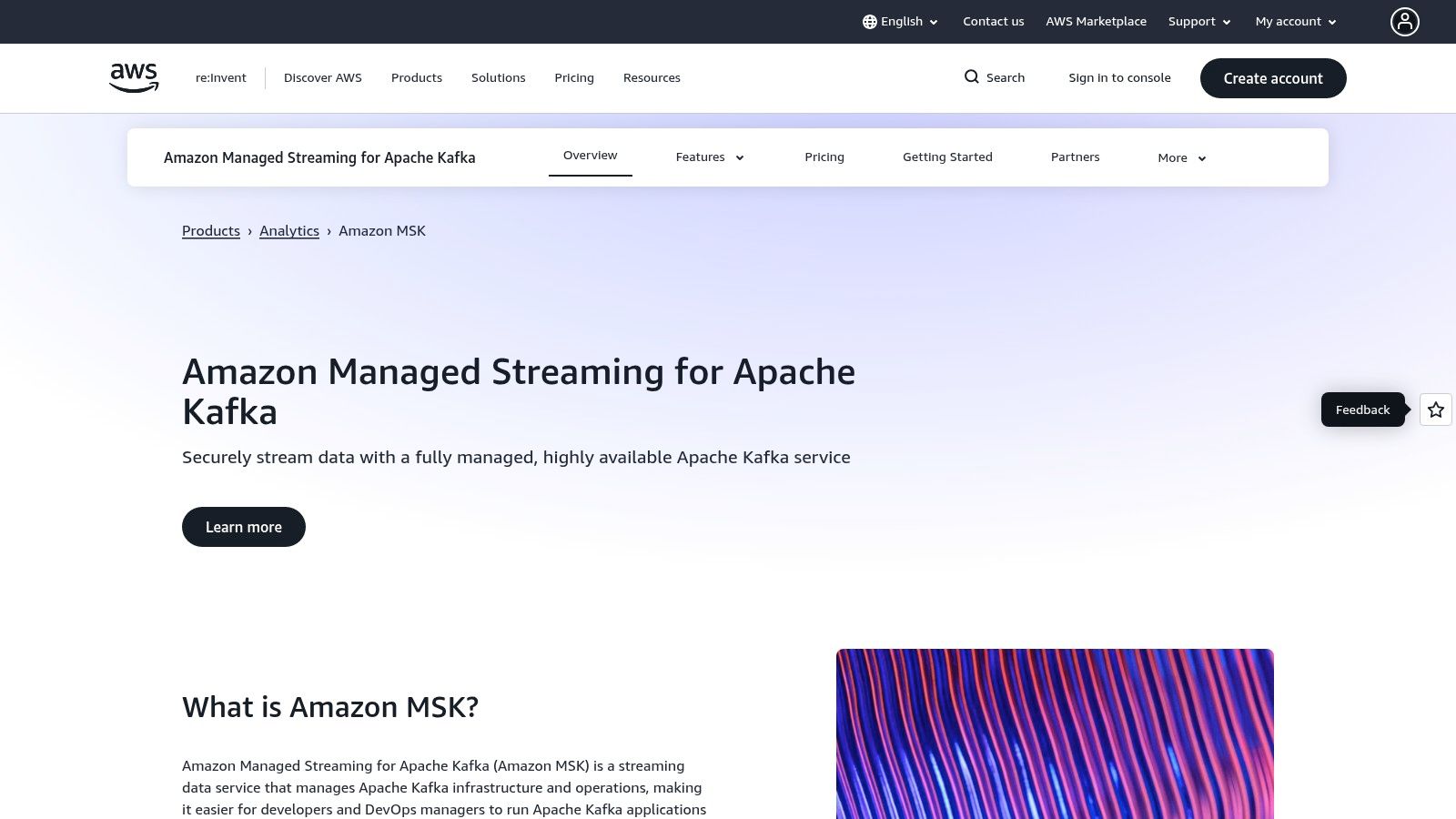
This platform simplifies the deployment and scaling of Kafka clusters within an existing AWS environment. Users benefit from features like MSK Connect, which provides a framework for running managed connectors without needing to operate a separate Kafka Connect cluster. While AWS handles the underlying infrastructure, teams are still responsible for managing Kafka-specific configurations like topic creation, partition strategies, and client-side tuning, which requires a degree of Kafka expertise.
Key Considerations & Use Cases
- Best For: Organizations building their data infrastructure primarily on AWS who require a managed Kafka service with tight security and networking integration.
- Pricing Model: Amazon MSK pricing is based on provisioned resources. Costs are calculated per broker-hour and per GB-month of storage. The serverless model uses a pay-as-you-go approach based on throughput and data retention, which can be simpler for unpredictable workloads but requires careful cost management.
- Tight, native integration with the broader AWS ecosystem (IAM, VPC, CloudWatch).
- Choice of provisioned or serverless models to align with workload patterns.
- Users still manage Kafka semantics and operational details like topic/partition tuning.
- Tuning clusters for optimal performance can be a non-trivial operational task.
For teams comparing managed Kafka offerings, understanding the operational differences is key. You can learn more about the specifics of managed Kafka solutions.
Website: https://aws.amazon.com/msk
4. Azure Event Hubs
For organizations deeply invested in the Microsoft Azure ecosystem, Azure Event Hubs presents a compelling Redpanda alternative that offers Kafka protocol compatibility without the need to manage Kafka brokers. This fully managed, real-time data ingestion service is designed for high-throughput event streaming and integrates seamlessly with other Azure services. It acts as a PaaS offering, allowing developers to focus on application logic rather than infrastructure management, making it an operationally simple choice for Azure-centric architectures.
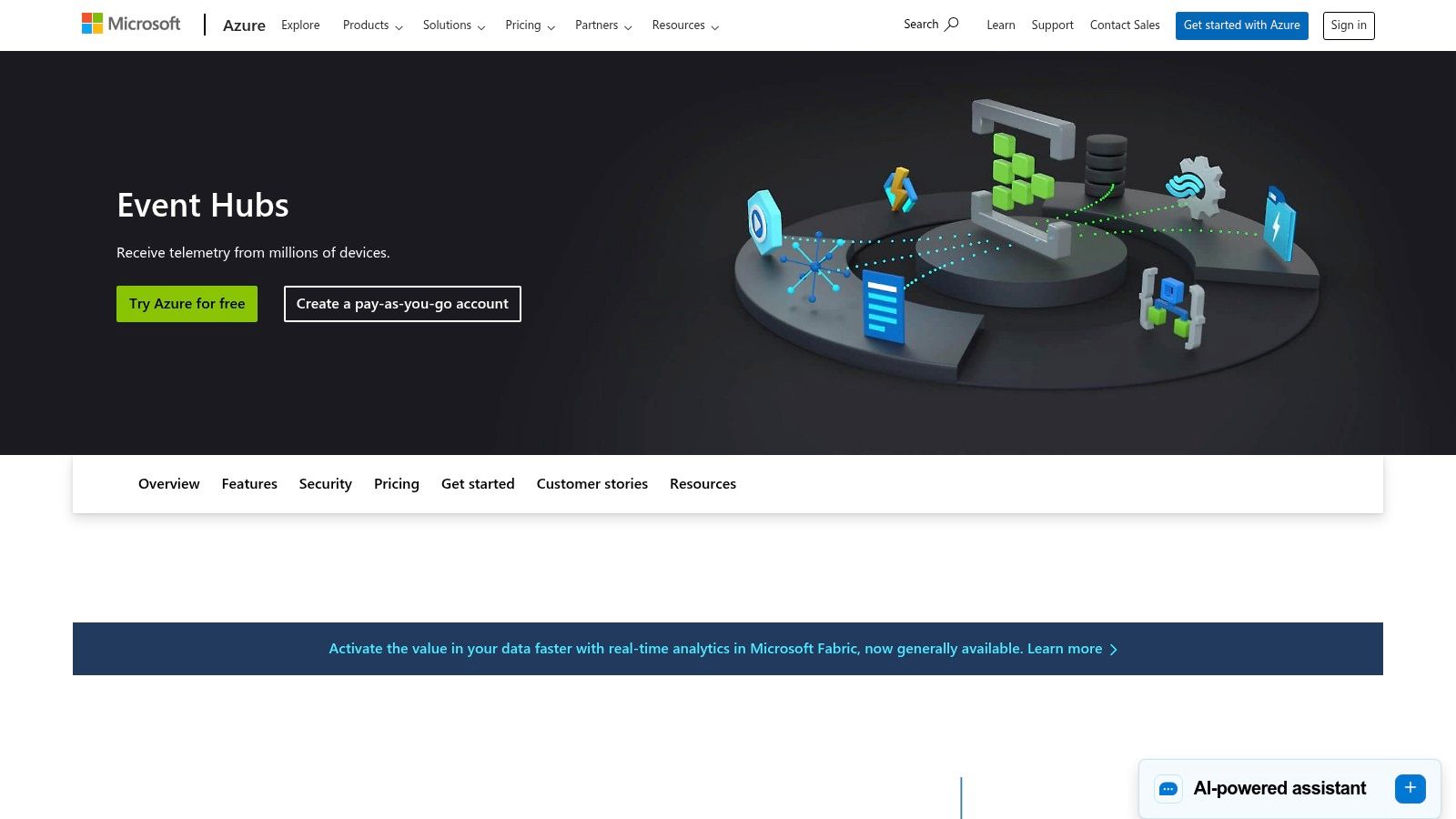
Event Hubs exposes a Kafka-compatible endpoint, enabling many existing Kafka client applications to connect with minimal configuration changes. It provides multiple service tiers (Standard, Premium, Dedicated) to meet different performance and isolation requirements, with features like auto-inflate to scale throughput units automatically. Its integrated Capture feature simplifies data archiving by automatically streaming events to Azure Blob Storage or Azure Data Lake Storage, streamlining the path from real-time ingestion to batch analytics. For developers exploring its implementation, guides on implementing Azure Event Hubs offer practical insights into its setup and capabilities.
Key Considerations & Use Cases
- Best For: Teams building on Azure who need a scalable event ingestion service with Kafka protocol support and tight integration with Azure security, monitoring, and data services.
- Pricing Model: Pricing is based on a combination of throughput units (TUs), which determine ingress/egress capacity, and the number of ingress events. Different tiers (Standard, Premium, Dedicated) have distinct pricing structures, with added costs for features like Capture and extended retention.
- Operationally simple, removing the burden of managing Zookeeper or Kafka brokers.
- Deep, native integration with the broader Azure ecosystem (e.g., Azure Functions, Stream Analytics, Storage).
- It is Kafka-compatible, not a 1:1 replacement; some advanced Kafka features, semantics, or client library functionalities may not be supported.
- Vendor lock-in to the Azure cloud platform is a significant consideration.
Website: https://azure.microsoft.com/services/event-hubs
5. Google Cloud Pub/Sub
Google Cloud Pub/Sub is a fully managed, serverless messaging service that serves as a compelling Redpanda alternative for organizations deeply integrated into the Google Cloud Platform (GCP) ecosystem. It provides global, real-time message delivery with nearly transparent scaling, removing the need for users to provision or manage brokers. Its primary strength lies in its simplicity and seamless integration with other GCP services, such as BigQuery, Dataflow, and Cloud Functions, making it ideal for event-driven, serverless architectures.

Unlike Redpanda or Kafka, which use a log-based architecture, Pub/Sub operates on a more traditional publish-subscribe model with push and pull subscriptions. It guarantees at-least-once message delivery and offers features like filtering, ordering keys, and seek/replay capabilities to reprocess historical messages. This makes it a powerful choice for decoupling services, ingesting streaming analytics data, and reliably distributing events across applications without the operational overhead associated with managing a distributed log system.
Key Considerations & Use Cases
- Best For: Teams building serverless, event-driven applications within the Google Cloud ecosystem or those prioritizing zero-ops management over Kafka API compatibility.
- Pricing Model: Pub/Sub follows a consumption-based model, charging primarily for data volume (throughput) after a generous monthly free tier (the first 10 GiB is free). Additional costs apply for features like message storage (snapshots) and inter-region data egress, but the pricing is generally straightforward and predictable.
- Truly serverless with near-zero operational burden; scales automatically and globally.
- Excellent native integration with GCP analytics tools like BigQuery and Dataflow.
- It is not a Kafka-compatible system; migrating from Kafka requires rewriting producers and consumers.
- Its messaging semantics and tooling differ significantly from the Kafka ecosystem.
Website: https://cloud.google.com/pubsub
6. Amazon Kinesis Data Streams
Amazon Kinesis Data Streams is a massively scalable and durable real-time data streaming service within the AWS ecosystem, positioning it as a strong Redpanda alternative for organizations deeply integrated with AWS. It manages the underlying infrastructure, allowing developers to focus on application logic rather than server management. Kinesis simplifies the process of collecting, processing, and analyzing streaming data in real-time, making it a go-to for use cases like real-time analytics, log and event data collection, and mobile data capture.
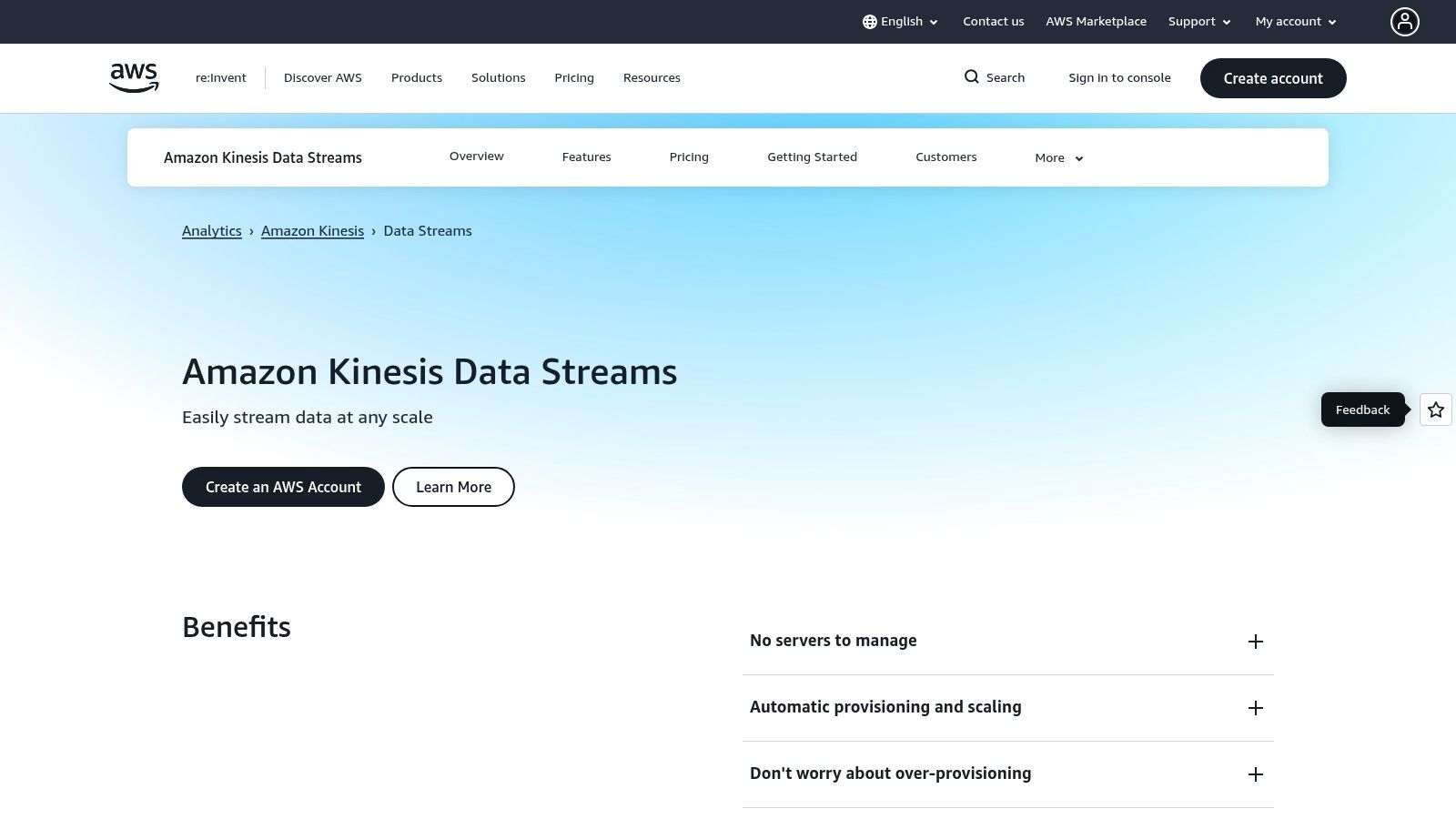
The service offers two capacity modes: on-demand, which automatically scales to accommodate workload traffic, and provisioned, which allows for specific shard allocation. Key features include extended data retention options up to a year and an enhanced fan-out capability that provides dedicated throughput for multiple consumers. This design, combined with its seamless integrations with other AWS services like Lambda, S3, and Redshift, makes it a powerful component for building serverless streaming architectures entirely within the AWS cloud.
Key Considerations & Use Cases
- Best For: Teams building event-driven applications entirely within the AWS ecosystem who want a fully managed, serverless streaming backbone without Kafka-API compatibility.
- Pricing Model: Kinesis uses a pay-as-you-go model. Costs are based on factors like throughput (shard hours or on-demand stream hours), data payload units (PUTs), and optional features like extended data retention and enhanced fan-out.
- Fully managed scaling and deep, native integrations with the AWS ecosystem.
- A mature, battle-tested service widely used for event pipelines in AWS.
- It is not a Kafka-compatible API; tooling and semantics differ significantly, requiring code adaptation.
- Applications designed for specific Kafka features or client behaviors may need a substantial redesign.
Website: https://aws.amazon.com/kinesis/data-streams
7. Apache Kafka (Self-managed)
For teams seeking maximum control and customization, self-managing open-source Apache Kafka is the original and most direct Redpanda alternative. This approach involves deploying, configuring, and maintaining your own Kafka clusters on your infrastructure, whether on-premises or in the cloud. It grants complete authority over hardware selection, network topology, performance tuning, and security implementation, avoiding any form of vendor lock-in.
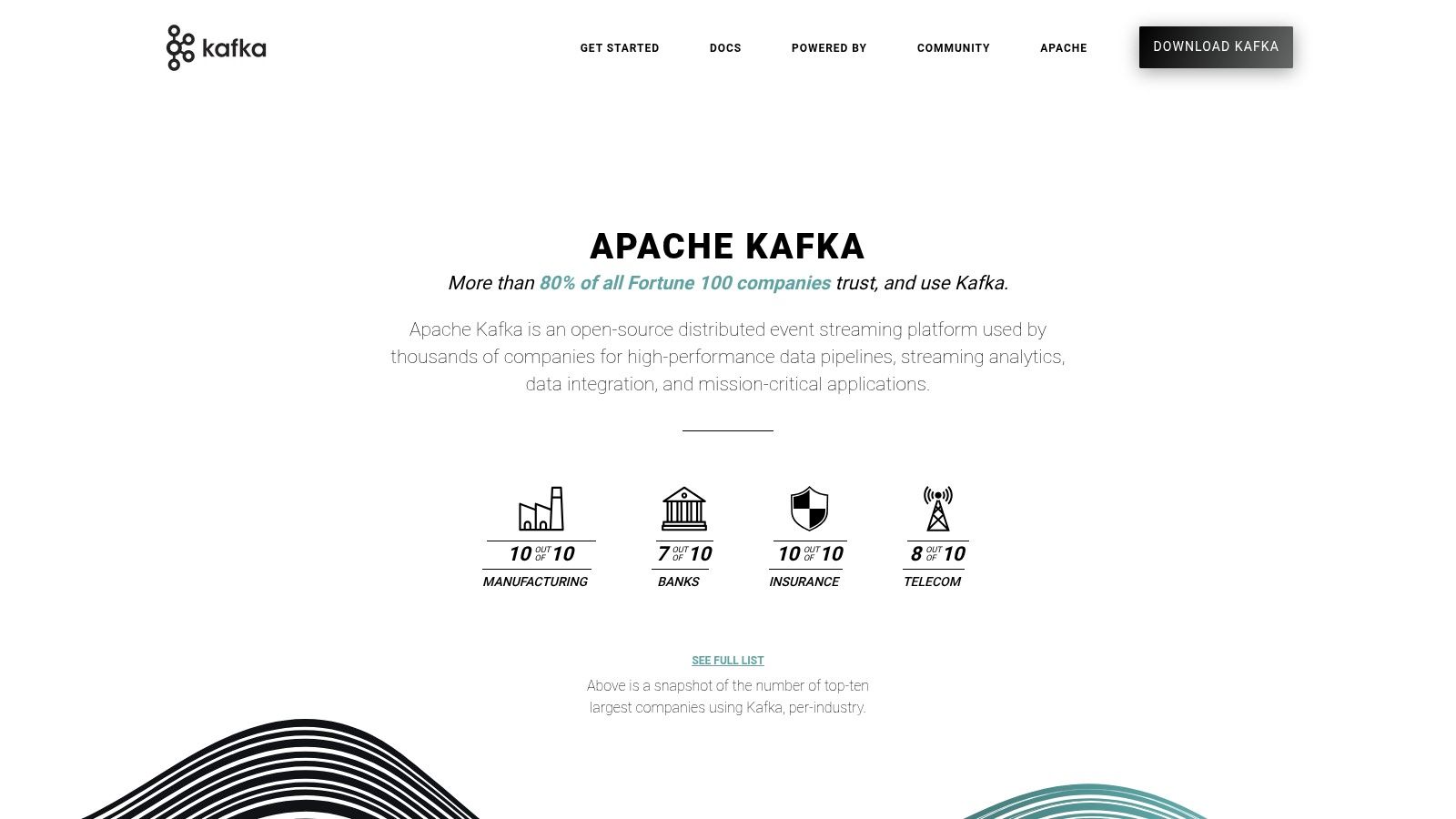
This option is defined by its deep, mature ecosystem and battle-tested reliability, supported by a vast global community. Self-hosting allows organizations to leverage Kafka's powerful primitives, such as exactly-once semantics and durable, ordered logs, without the constraints or pricing models of a managed service. This path is ideal for organizations with the requisite in-house expertise to handle the significant operational responsibilities, including capacity planning, software upgrades, monitoring, and disaster recovery.
Key Considerations & Use Cases
- Best For: Organizations with a dedicated operations or platform engineering team that require full control over their data infrastructure for cost optimization at scale or specific compliance needs.
- Pricing Model: The cost is based entirely on your own infrastructure (compute, storage, networking) and the personnel required to manage it. While there are no licensing fees for the open-source software, the total cost of ownership (TCO) can be substantial.
- Complete control over deployment, configuration, and performance tuning.
- No vendor lock-in and potential for significant cost savings at very large scale.
- High operational overhead requires significant, dedicated expertise.
- Teams are solely responsible for uptime, scaling, upgrades, and security patching.
For teams weighing the operational trade-offs, you can discover more about improving data pipelines with Kafka alternatives.
Website: https://kafka.apache.org
8. WarpStream
WarpStream introduces a novel architecture as a Redpanda alternative, offering Kafka protocol compatibility while fundamentally changing the underlying storage mechanism. It decouples compute from storage by using stateless agents for processing and leveraging object storage (like Amazon S3) as the primary data layer. This design aims to drastically reduce the infrastructure and data replication costs associated with traditional broker-based systems like Kafka or Redpanda, which rely on local disk storage and synchronous replication.
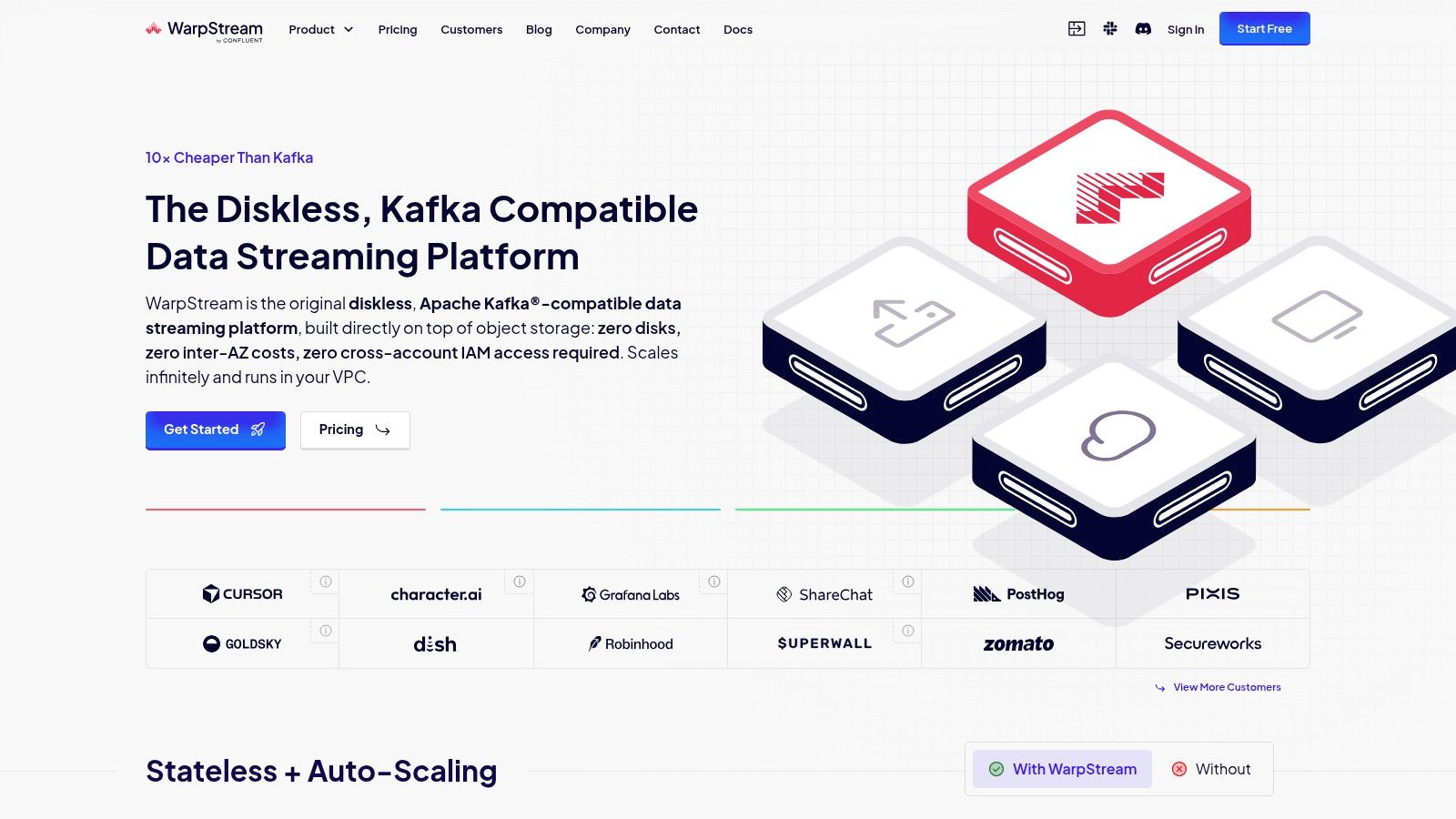
The core appeal of WarpStream is its operational simplicity and cost-efficiency. By offloading data durability to cloud object storage, it eliminates the need for expensive cross-AZ data replication at the broker level, a significant cost driver in high-availability Kafka setups. Its bring-your-own-cloud (BYOC) model means data resides in the user's own object storage bucket, providing data sovereignty and control. This approach simplifies cluster management, as the agents are stateless and can be scaled independently based on load without complex data rebalancing.
Key Considerations & Use Cases
- Best For: Teams looking to minimize the total cost of ownership for their data streaming infrastructure, particularly those with spiky workloads or who want to simplify operations by eliminating broker state management.
- Pricing Model: WarpStream's pricing is based on data transfer, not on provisioned broker capacity or storage. It charges a fee per gigabyte of data written and read through its agents, which can make costs more predictable and directly tied to usage.
- Significant potential for cost reduction by leveraging cheap object storage and avoiding cross-AZ replication fees.
- Stateless architecture simplifies scaling, operations, and disaster recovery.
- It is not a direct Apache Kafka implementation; edge-case compatibility with specific client libraries or tools should be validated.
- Performance characteristics, especially latency, may differ from disk-based systems and require testing for sensitive workloads.
Website: https://www.warpstream.com
9. Upstash Kafka (Serverless Kafka)
Upstash Kafka provides a serverless, Kafka-compatible messaging service designed specifically for serverless and edge computing environments. It presents itself as a unique Redpanda alternative by offering a REST API alongside the standard Kafka protocol, solving the challenge of managing long-lived TCP connections in ephemeral runtimes like AWS Lambda or Vercel. This approach allows developers to integrate event-driven architecture into their serverless functions without the overhead of traditional client libraries or connection pooling. Its core value is simplicity and accessibility for modern, event-driven applications.
The platform is built for cost efficiency and predictable spending. It scales to zero automatically, ensuring users do not pay for idle resources. Furthermore, its pay-per-message model is complemented by monthly price caps for each cluster tier, which eliminates the risk of runaway costs often associated with consumption-based pricing. Upstash also includes serverless connectors for sources like MongoDB, Debezium, and JDBC, with their usage billed under the same simple per-message activity, simplifying the integration of data streams without adding complex new billing dimensions.
Key Considerations & Use Cases
- Best For: Developers building serverless or edge applications that require a simple, pay-as-you-go messaging queue with Kafka compatibility and HTTP-based access.
- Pricing Model: A straightforward pay-per-message model with a generous free tier. Paid plans offer higher throughput and message limits with a fixed monthly price cap, providing cost predictability.
- Excellent fit for serverless and edge runtimes where traditional Kafka clients are impractical.
- Predictable and transparent pricing with fixed monthly caps prevents unexpected bills.
- Throughput is limited on lower-cost tiers, making it unsuitable for ultra-high-volume use cases.
- The REST API adds latency and has different performance characteristics compared to a persistent TCP connection.
Website: https://upstash.com/kafka
10. Aiven for Apache Kafka
Aiven for Apache Kafka offers a fully managed, open-source data streaming platform, positioning itself as a strong Redpanda alternative for teams prioritizing predictable costs and multi-cloud flexibility. It simplifies Kafka operations by providing production-ready clusters across all major cloud providers (AWS, GCP, Azure) with an all-inclusive pricing model. This approach bundles compute, storage, networking, and operational tooling into fixed monthly plans, eliminating the complexity of consumption-based billing.

The platform is designed for operational simplicity and developer convenience. Aiven handles all the underlying infrastructure management, including automated backups, security patching, and seamless upgrades. It also includes powerful features like VPC peering for secure network integration and offers a suite of managed connectors through Aiven for Apache Kafka Connect. This makes it straightforward to set up and maintain a robust Kafka environment without deep infrastructure expertise, allowing teams to focus on building their data pipelines rather than managing cluster mechanics.
Key Considerations & Use Cases
- Best For: Organizations that want a managed Kafka service with transparent, predictable pricing and the flexibility to deploy on any major cloud.
- Pricing Model: Aiven uses a plan-based pricing model. Users select a plan tier with fixed resources (CPU, RAM, storage) for a set monthly cost. This all-inclusive model covers infrastructure and data transfer, simplifying budget forecasting significantly.
- Predictable, all-inclusive pricing plans prevent surprise costs.
- Multi-cloud support provides deployment flexibility and avoids vendor lock-in.
- Plan-based tiers offer less granular scaling compared to usage-based models.
- Less cost-effective for workloads with highly variable or spiky traffic patterns.
Website: https://aiven.io
11. StreamNative Cloud (Managed Apache Pulsar)
StreamNative Cloud provides a fully managed Apache Pulsar service, presenting a compelling Redpanda alternative for teams looking beyond the Kafka API. Pulsar's architecture, which decouples compute from storage, is designed for massive scale, native multi-tenancy, and seamless geo-replication. This makes it a strong choice for organizations with complex, multi-regional deployments or those requiring isolation between a large number of tenants or use cases on a single cluster.
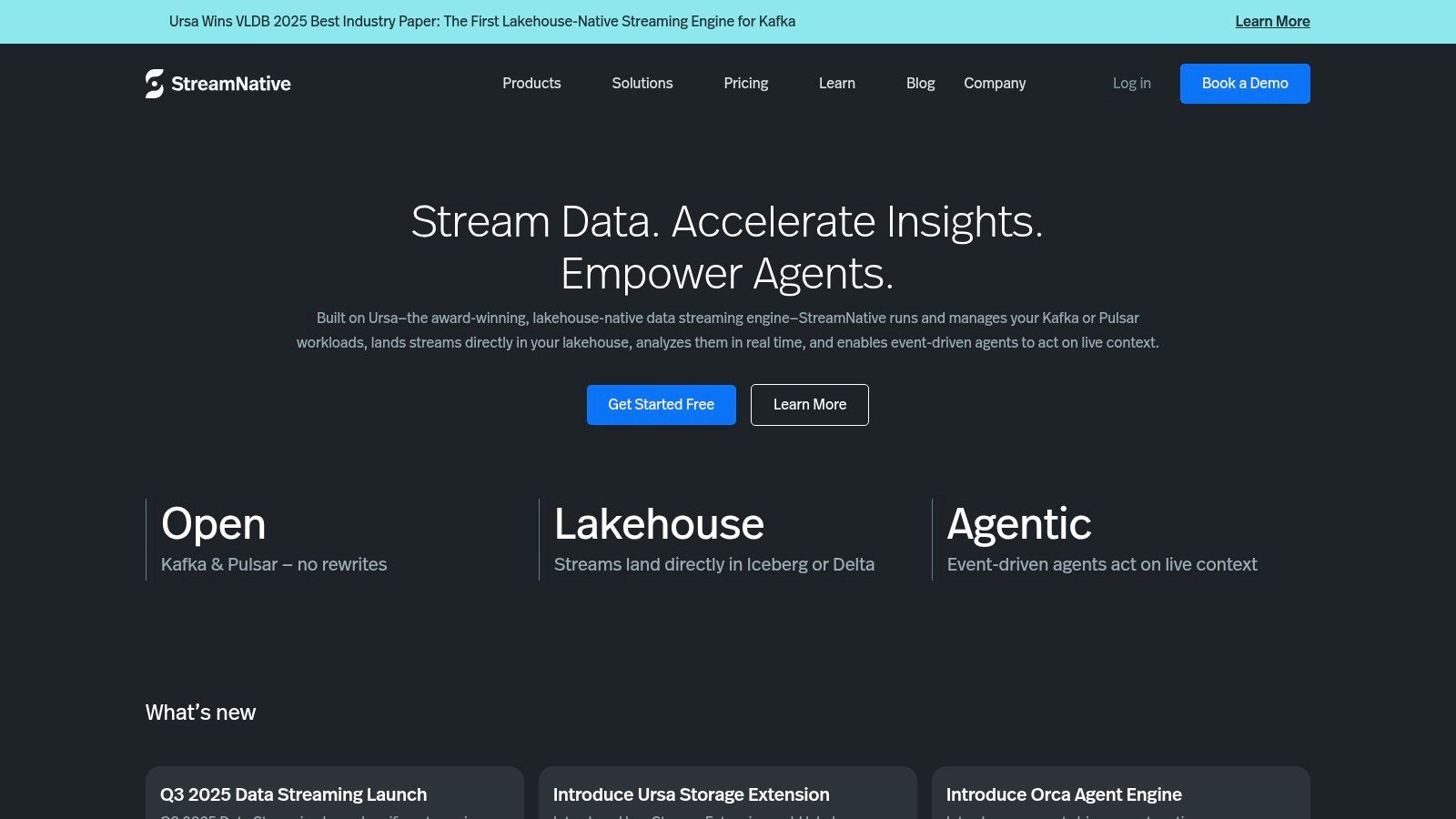
The platform abstracts away the complexity of managing Pulsar's components like brokers, bookies, and Zookeeper, allowing developers to focus on application logic. It excels in scenarios that demand a very high number of topics, as Pulsar's design avoids the per-partition overhead found in Kafka-like systems. StreamNative also offers built-in tiered storage, which automatically offloads older data to cost-effective object storage, and lightweight serverless functions for in-stream processing.
Key Considerations & Use Cases
- Best For: Organizations requiring massive scalability with a high topic count, strong multi-tenancy for isolating teams or customers, and built-in geo-replication capabilities.
- Pricing Model: StreamNative Cloud uses a consumption-based pricing model based on "Consumption Units" (CUs). Costs are calculated based on provisioned capacity for components like brokers and bookies, along with data throughput, storage, and cross-region replication traffic.
- Pulsar architecture is inherently built for multi-tenancy and scaling to millions of topics.
- Built-in tiered storage and flexible consumption patterns can optimize costs.
- It is not a drop-in Kafka replacement; migrating requires significant effort to adapt clients, tooling, and operational knowledge.
- The Pulsar ecosystem is less mature than Kafka's, with fewer pre-built integrations.
Website: https://streamnative.io
12. CloudAMQP (Managed RabbitMQ)
CloudAMQP provides a fully managed RabbitMQ service, positioning itself as a practical Redpanda alternative for workloads where message queue semantics are a better fit than a commit log. It is designed for developers who need reliable, at-most-once or at-least-once message delivery for task queues, background job processing, and real-time pub/sub scenarios. The platform simplifies RabbitMQ operations by offering everything from free development instances to dedicated, multi-AZ clusters with 24/7 support.
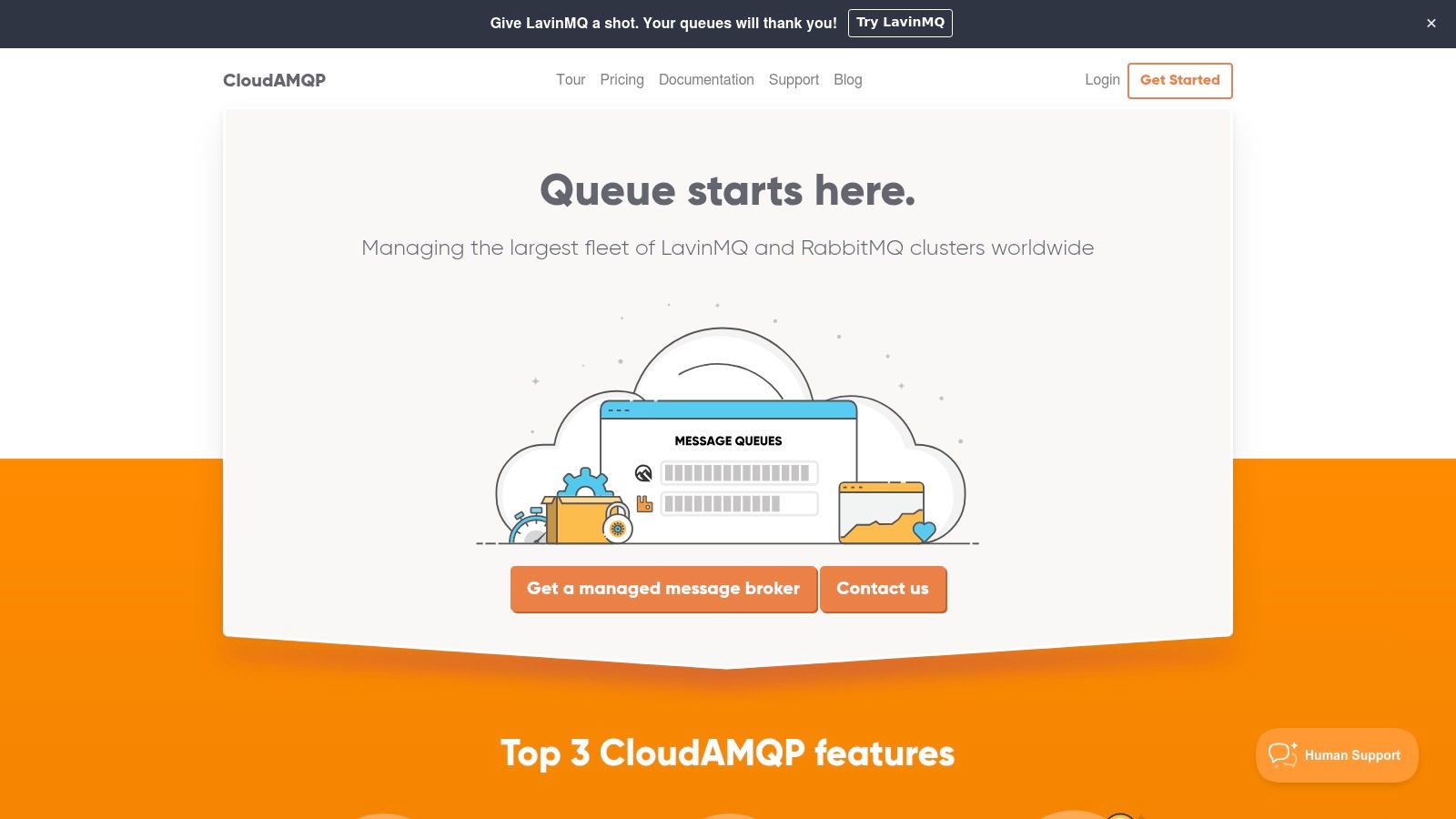
This service shines in its ease of use and rapid onboarding, complete with mature dashboards and monitoring tools that give clear insights into queue performance. While RabbitMQ's log-less architecture differs from Redpanda's, it excels in complex routing and transient messaging patterns. Dedicated plans support multiple protocols, including AMQP, MQTT, STOMP, and WebSockets, offering broad flexibility. For teams evaluating RabbitMQ, understanding how to implement efficient asynchronous tasks with Celery, RabbitMQ, and Redis can be highly beneficial for building robust applications.
Key Considerations & Use Cases
- Best For: Teams needing a managed, traditional message broker for work queues, microservices communication, and scenarios where complex message routing is required.
- Pricing Model: CloudAMQP offers a range of plans, from a free tier for small projects to fixed-price dedicated instances. Billing is transparent and often per-second on instances, making costs predictable based on cluster size and not on data throughput.
- Extremely fast onboarding with well-established tooling and a simple user interface.
- Excellent fit for task queues and traditional pub/sub use cases common in web applications.
- Message delivery and ordering semantics are fundamentally different from Kafka-API compatible systems.
- Not designed for long-term event storage and stream replays without careful architectural planning.
Website: https://www.cloudamqp.com
Top 12 Redpanda Alternatives: Feature & Pricing Comparison
Choosing the Right Streaming Path for Your Team
The journey to find the right Redpanda alternative reveals a vibrant and diverse ecosystem of data streaming technologies. Your final decision will not be about finding a single "best" tool, but about identifying the platform that aligns perfectly with your team's specific operational capacity, technical requirements, and strategic goals. We've explored everything from the raw power of self-managed Apache Kafka to the cloud-native convenience of services like Amazon MSK and Google Cloud Pub/Sub, and the unique, object-storage-based architecture of WarpStream.
This exploration underscores a critical theme: the ideal streaming solution is a balancing act. It involves weighing the desire for granular control against the high operational cost of managing complex infrastructure. It means evaluating the benefits of a familiar Kafka API against the specialized capabilities of platforms like Apache Pulsar or the simplicity of message queues like RabbitMQ.
Key Takeaways and Decision Framework
As you move forward, revisit the core questions that will guide your selection process. Your answers will illuminate the most suitable path for your organization.
Operational Burden vs. Control: How much time and expertise can your team dedicate to managing infrastructure? If you have a dedicated platform engineering team, self-managed Kafka or even a managed service like Aiven offers immense control. If your goal is to minimize operations and focus solely on data pipelines, a zero-ops platform like Streamkap or a serverless option like Upstash Kafka is far more efficient.
Integration and Ecosystem Needs: What are your primary data sources and destinations? If your world revolves around Change Data Capture (CDC) from databases like Postgres, MySQL, or MongoDB and your destination is a cloud data warehouse like Snowflake, BigQuery, or Databricks, a solution with pre-built, managed connectors is non-negotiable. This is where a platform abstracting both Kafka and Flink complexity provides immense value.
Performance and Scalability Requirements: What are your peak throughput and latency needs? For extreme low-latency use cases, a self-hosted, performance-tuned solution might be necessary. However, for most real-time analytics and data movement workloads, managed services have evolved to provide impressive, elastic scalability without the manual intervention, making them a more practical choice.
Cost Model and Predictability: How do you prefer to manage costs? Pay-as-you-go models offered by cloud providers like AWS Kinesis and Azure Event Hubs are excellent for spiky, unpredictable workloads. In contrast, if your goal is predictable spending and a lower Total Cost of Ownership (TCO) by eliminating engineering salaries for cluster management, a fully managed, all-inclusive platform presents a compelling financial argument.
Final Thoughts on Your Streaming Future
Choosing a Redpanda alternative is a strategic decision that will shape your data architecture for years to come. The modern data stack is shifting away from the belief that every team must build and manage their own streaming infrastructure from scratch. The real competitive advantage lies not in managing brokers and partitions, but in rapidly building and deploying data products that deliver business value.
By carefully evaluating your team's skills, budget, and ultimate business objectives, you can select a solution that acts as a powerful enabler rather than an operational bottleneck. Whether you opt for the ultimate control of a self-managed cluster, the balanced approach of a managed Kafka provider, or the zero-ops efficiency of a specialized data movement platform, the right choice will empower your team to harness the full potential of real-time data.
Ready to eliminate the complexities of managing Kafka, Flink, and data connectors? Streamkap offers a powerful Redpanda alternative focused on zero-ops, real-time CDC and data movement to your cloud warehouse. See how you can build production-ready pipelines in minutes, not months, by exploring our platform at Streamkap.



